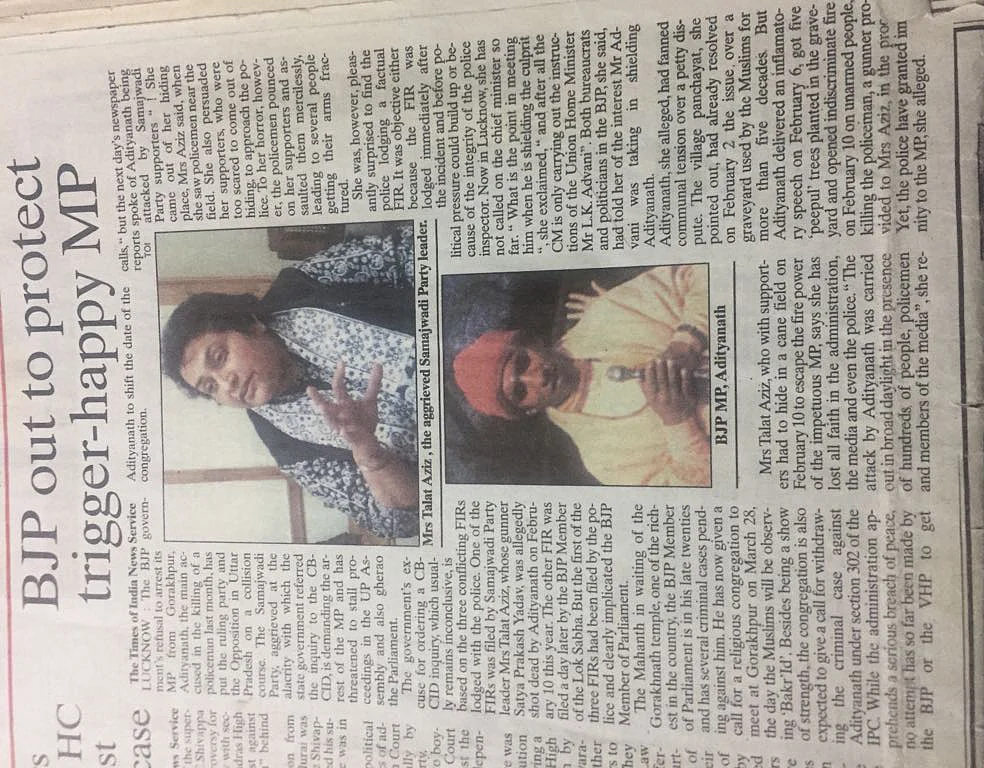The murder case pending against the UP Chief Minister
While the media by and large have glossed over the criminal cases pending against him, the new Uttar Pradesh chief minister has been accused of serious charges including killing a policeman

In keeping with contemporary Indian media’s reluctance to tell stories, warts and all, only one TV channel on Saturday, ABP News, mentioned the murder case against the new Uttar Pradesh Chief Minister Yogi Adityanath, BJP’s new ‘Hindu Hriday Samrat 2.00’ with the alpha version being Prime Minister Narendra Modi himself.
The Gorakhpur MP and now chief minister of the most populous state is not accused of the murder of any member of the minority community but of a policeman, Satya Prakash Yadav. Assigned for the security of Talat Aziz, who contested for the assembly seat from Paniyara, Maharajganj this year on a Congress ticket and lost, Yadav was killed in February, 1999 when Aziz was in the Samajwadi Party.

Ironically Aziz appeared on television to recall that she was resisting an attempt by Yogi and his men to occupy a graveyard (Kabristan) in village Panchrukhia, reminding viewers of Prime Minister Modi’s poll rhetoric in Uttar Pradesh this year over Kabristan vs Shamshan (graveyards vs cremation grounds).
The new UP CM’s polarising potential has been handled so far with kid gloves by the media. And while the murder case is expected to fizzle out, now that he occupies the chief minister’s chair, there are several other criminal cases still pending against him. Court has taken cognisance of several of them and they will continue to dog the new CM for some time.
Three charges related to rioting (IPC Section-147); one of attempt to murder (IPC Section-307); two pertaining to rioting, armed with deadly weapons (IPC Section-148); one case of endangering life or personal safety of others (IPC Section-336); another related to all members of unlawful assembly guilty of offence committed in prosecution of common object (IPC Section-149); two charges of trespassing on burial places etc. (IPC Section-297); and another of criminal intimidation (IPC Section-506) are said to be still pending against him.
Adityanath spent 10 days behind bars on charges of rioting in 2007, following which the then District Magistrate Hari Om, who had arrested him, was transferred from Gorakhpur.
His stature as a firebrand Hindutva political icon derives from his lineage as head of the Gorakhnath Peeth of Nath Sampradaya or sect. The five-time MP Adityanath’s father, as mentioned in his Lok Sabha profile and election affidavit, Mahant Avaidyanath, whom he publicly hails as his Gurupita or ‘father-like-teacher’, too wore his street-smart Hindutva politics on his sleeves with his rabble rousing role in cow protection and Ayodhya temple movements, first as a Hindu Mahasabha MP in late 1960s and later as a BJP MP in 1990s after RSS and BJP formally adopted the movement in 1980s.
Born as Ajay Singh Bisht in Pauri Garhwal (Uttarakhand), he adopted Adityanath as his name when initiated into Sanyas by Mahanth Avaidyanath. He is related to journalist Arvind Singh Bisht of Lucknow who is the father of Aparna Yadav, the second daughter-in-law of Mulayam Singh Yadav.
Avaidyanath’s predecessor Mahanth Digvijay Nath, though starting off as a Congressman during the Non-cooperation Movement of 1921 was sucked into the vortex of Hindutva politics when he joined the Hindu Mahasabha in 1937. Even in 1921, he was accused of a role in the violent Chauri-Chaura incident which embarrassed a non-violent Mahatma Gandhi into calling off the movement.
As a Hindu Mahasabha leader, Digvijay Nath found himself on the wrong side of the law with his public exhortations to kill the Mahatma in the days before Mahatma Gandhi was assassinated. He was the first Hindutva leader to organise the Ayodhya temple movement in 1948-49 and under his aegis Ram, Sita and Lakshman idols were installed in the Babri Mosque in 1949, marking the beginning of a long, almost 70-year long conflict that continues to haunt the nation.
Like his two predecessors Yogi Adityanath too has Hindu Mahasabha connections even though he has been a BJP member of the Lok Sabha since 1998. He has also floated a number of other Hindutva organisations and vigilante groups of his own for conversion to Hinduism and prevent inter-community marriages. He is also associated with RSS-affiliated Vishwa Hindu Parishad and Bajrang Dal.
It is this background that defines his iconic stature and his persona that resembles Gandhi’s assassin Nathuram Godse and reflects the confluence of two Hindutva politics streams.
Follow us on: Facebook, Twitter, Google News, Instagram
Join our official telegram channel (@nationalherald) and stay updated with the latest headlines
- Lok Sabha
- prime minister
- Congress
- BJP
- Narendra Modi
- Hindu Mahasabha
- Nathuram Godse
- RSS
- Amit Shah
- Uttar Pradesh
- Gujarat
- Ayodhya
- Samajwadi Party
- District Magistrate
- Gorakhpur
- Babri Masjid
- Uttar Pradesh Chief Minister
- Mahatma Gandhi
- Muslim
- Hindutva
- rioting
- 2002 riots
- Vishwa Hindu Parishad
- Yogi Adityanath
- Gorakhnath
- Bajrang Dal
- kabristan
- IPC
- ABP News
- Hindu Hridaya Samrat
- Satya Prakash Yadav
- Talat Aziz
- Panchrukhiya
- Rashtriya Swayamsewak Sangh
- Section 147
- attempt to murder
- Section 307
- Section 148
- Section 336
- Section 149
- Section 297
- cases
- criminal intimidation
- Section 506
- Hari Om
- Sampradaya
- Mahant Avaidyanath
- Mahanth Digvijay Nath
- Chauri Chaura